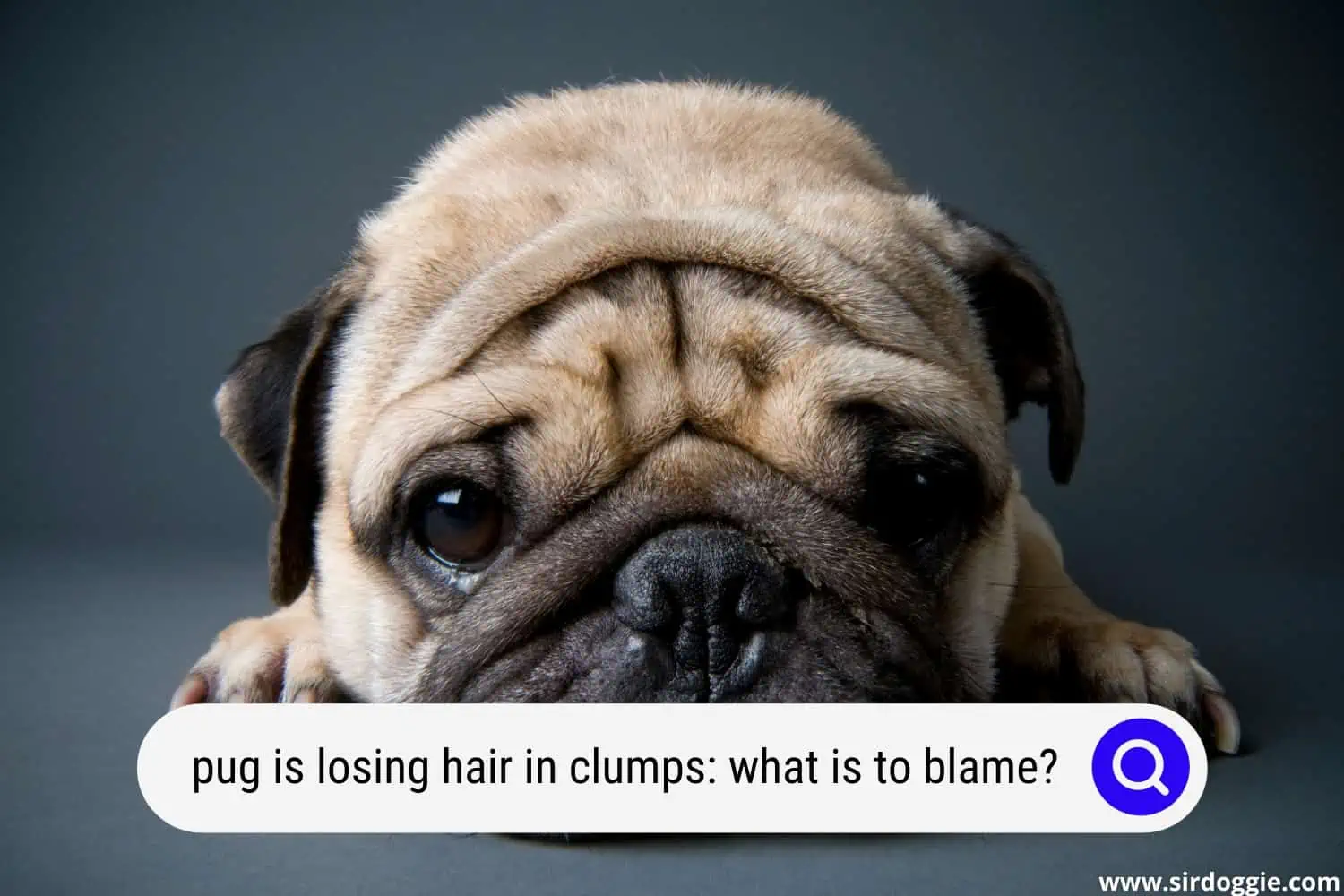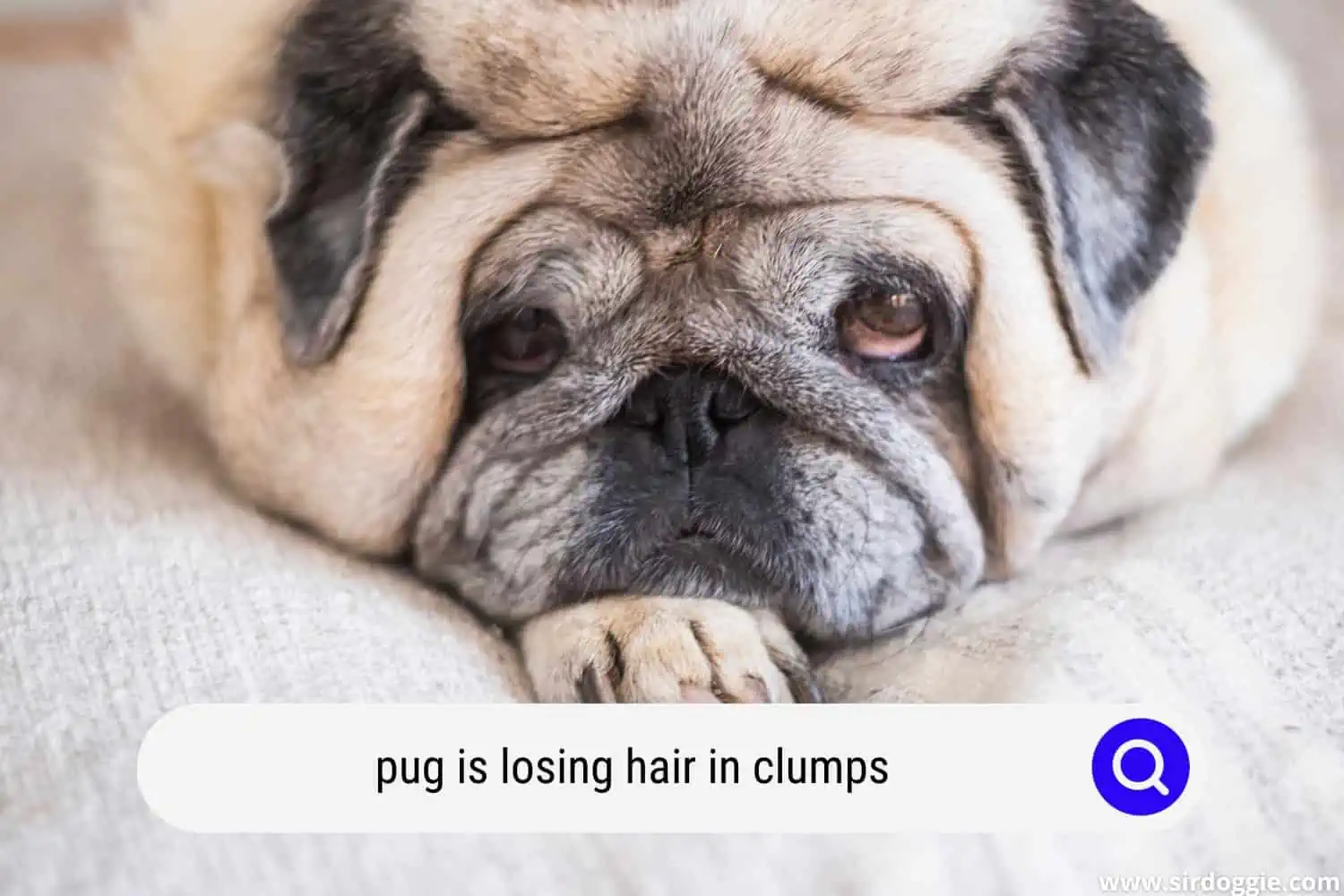Pug Is Losing Hair In Clumps: What Is To Blame?
Any devoted and caring pet parent will be paying attention to his/her dog’s wellbeing. That means doing everything possible to fix any health issues that may come up during a pooch’s lifetime. Including hair loss issues if they happen to take place.
A mutt’s mane is a good indicator giving a dog owner information on his/her hound’s health. If its hair is nice, thick, and shiny, then your fur baby is in tip-top shape. However, if you notice that its hair is dull, brittle, and slowly thinning out, there might be time to pay a much-needed visit to the veterinarian. And if we take Pugs as an example, what if your Pug is losing hair in clumps? What reasons can we name for such an unfortunate situation? We will cover it shortly. For now, let’s cover all the major health problems this toy breed is prone to.

Related Reading: Do Pugs Have Down Syndrome?
The Main Health Problems Pugs Are Prone To
- Breathing: since Pugs are known to have a brachycephalic syndrome, their flat faces, and tiny noses don’t allow for normal airflow. Therefore pet parents can often hear their fur babies making wheezing and snuffling noises. It is just something all Pugs are born with and this issue can only be surgically corrected. Keep an eye on your little fluffy friend: if its breathing issue escalates, it might be time to take it to the vet and follow his/her instructions.
- Hyperthyroidism or Hypothyroidism: Pugs have also been known to have various thyroid problems, like hypothyroidism and hyperthyroidism. These take place when a pooch’s thyroid is either producing too much or too little of the hormone triiodothyronine. This can lead to major weight gain, “cranky” behavior, cold intolerance, liver problems, and extensive hair loss. If you notice any of those symptoms-take your hairless Pug to the doctor without delay!
- Cardiovascular Ailments: these can be caused by either obesity or brachycephaly. If it is indeed the former issue, then a dog owner might have to cut his/her precious pup’s meal portions in half. Also, substitute its cookie treats for a more healthy alternative like sliced fresh fruits and veggies. Weight gain causes a Pug’s heart to pump blood harder through those clogged blood vessels and limits its physical activity. However, if it is the latter issue, certain guidelines might help a Pug have a healthier, stress-free life. Keep your Pug away from extreme temperatures: when it’s very cold or hot out, it might hinder a fluffy pal’s normal breathing. This, in turn, can cause the heart to work extra hard to get that oxygen to all the main body organs. In case you notice your friend is panting heavily during the hot days of summer, bring it inside to an air-conditioned room and give it plenty of water. If you see it’s shivering in the winter, invest in a good-quality winter jacket and let it curl up by the fireplace once it has done its business outside.
- Weight Gain: oh yeah, unfortunately, Pugs are very prone to developing obesity, therefore an owner must watch fur baby’s portions and not let it over-eat. Substitute unhealthy snacks for some raw fruits, berries, and crunchy veggies. You just have to watch which ones are your pup’s favorites. And, please, no-table food! I know it might be tough not to share when those big, cute begging brown sparkles are piercing through your soul as you are enjoying your dinner. However, refrain for your mutt’s sake.
But what if your Pug is losing hair in clumps? Which health issues are to blame? Let’s dig into it.
Related Reading: How Expensive Are Pugs? A Pet Parent’s Guide To Introducing A New Family Member
My Pug Is Losing Hair In Clumps: What Are The Main Reasons?
As briefly mentioned above, one of the reasons a Pug is losing hair in clumps could be thyroid abnormalities. However, there are other hair-loss-causing issues we are about to discuss as well.
- Hyper- or Hypothyroidism are the two health concerns leading to massive shedding in all the canines, not just Pugs. Even though the latter is known for developing them more often than some of the other breeds. That is all because of the thyroid hormone’s abnormal functioning which affects a wrinkle-faced mane and a Pug is losing hair at the speed of lightning. If the extreme shedding happens during colder months that is a very alarming sign! Normally pooches would shed in the spring, getting rid of all those old “winter coats,” preparing for the upcoming hot summer days. Yet, if you see unusual winter shedding, it might be related to thyroid issues. Take your mutt to a trusted veterinary specialist for answers as soon as possible.
- External parasites can also be the cause of a puppy’s bald spot on the head as well as bold round patches all over the body. Fleas, ticks, and mites can greatly irritate a fluffy pal’s skin to the point of developing severe skin rashes. A suffering canine would be engaging in a lot of scratching, therefore small wounds could appear on the skin’s surface as well. It is imperative to inspect your beloved Pug’s derma and mane regularly to detect any signs of “unwelcomed guests.” In case you notice any, remove them with a clean paper towel or a napkin and apply a little drop of tea tree oil to prevent infection if there’s bleeding. And it is better to implement preventative parasite measures to bring canine infestation to a minimum. Try flea and tick collars, solutions, or special pills to help fight pests.
- Skin Infections: like any other dog, Pugs are prone to skin infections. Pancake-faced are at even higher risk of developing skin allergies, rashes, and eczemas just because of their genetic makeup. Pay attention to disturbing signs like a pet going in circles, excessive licking, and wild scratching at the affected spots. Consult a veterinarian about steps you can take to eliminate the worrisome skin condition.
- Cushing’s Disease: This happens when a pet’s adrenal gland produces too much of the hormone cortisol which leads to weight gain, mood swings, heavy shedding, and fatigue. It can be usually managed by medications that a veterinary professional prescribes depending on the severity of the case.

Curl-Up
Whatever reason might be that your Pug is losing hair in clumps, it is something that has to be addressed without delay. It could be an indicator of a serious problem like allergies, parasites, serious skin conditions as well as thyroid problems. Always inspect your pooch’s skin and coat to see if there’s anything wrong, or any abnormalities that should be looked at. Pay attention to your pal’s behavior: constant licking, scratching, biting, and whining while doing that will be a way for your dog to communicate to you its frustration. Read those signals carefully: it might help save your dog’s life in the long run!
Related Reading: Do Pugs Shed A Lot?

Family Dog Expert Author
Hi there! I’m Stuart, a devoted dog lover and family dog expert with over a decade of experience working with our furry companions. My passion for dogs drives me to share my knowledge and expertise, helping families build strong, loving bonds with their four-legged friends. When I’m not writing for SirDoggie, you’ll find me hiking, playing with my beautiful dog, or studying music.